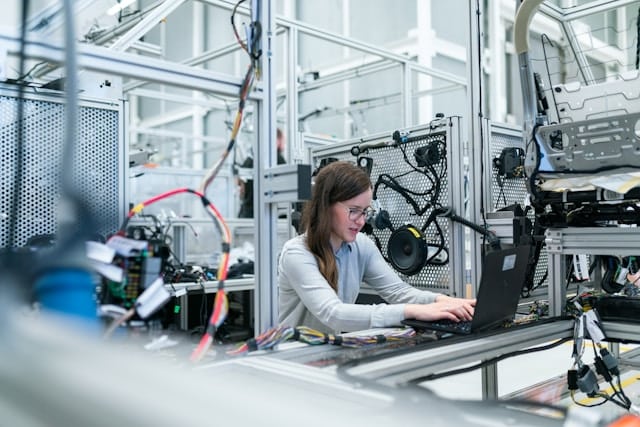In the demanding sphere of manufacturing, keeping equipment and machinery in optimal condition is a constant challenge. The downtime resulting from unexpected breakdowns can significantly affect productivity and overall costs. In an effort to mitigate potential risks and reduce maintenance costs, many manufacturers are now turning to predictive analytics. By utilizing advanced technologies such as Artificial Intelligence (AI), companies are able to conduct root cause analysis more effectively, identifying potential problems before they escalate. This proactive approach supports better decision-making, increased efficiency, and significant cost savings.
Making Sense of Data with Machine Learning
Machine Learning (ML), a subset of AI, is an essential tool in the manufacturing sector’s predictive maintenance toolkit. It works by analyzing large volumes of data and learning from it to make predictions about future events. This capability allows it to identify potential equipment failure before it happens, giving manufacturers time to rectify the issue and avoid unnecessary downtime.
Also to read : What Role Do Advanced Telematics Systems Play in Fleet Management Efficiency?
For example, ML algorithms can evaluate data from sensors installed on manufacturing machinery to monitor performance. By analyzing data patterns over time, these algorithms can identify anomalies that may indicate a potential problem. This could be a change in vibration patterns, an increase in temperature, or any other irregularity that deviates from the norm. Once an issue is identified, the root cause can be determined and addressed, often before it causes any significant disruption.
Predictive Analysis and Quality Control
In addition to detecting potential equipment failures, AI can also play a pivotal role in improving product quality. In manufacturing, quality control is key to maintaining customer satisfaction and avoiding costly recalls or rework.
Have you seen this : Can Smart Agricultural Drones Accurately Predict Crop Yields Using Machine Learning?
Predictive analytics can be used to monitor and assess the quality of products during the production process. This involves analyzing data from various stages of production to identify any deviations from the expected quality standards. If any anomalies are detected, this could suggest a potential issue with the equipment or the production process.
For instance, if the data reveals a consistent decline in the quality of products being produced, this could indicate a gradual deterioration in the performance of a particular machine. By identifying and addressing the root cause early, it is possible to prevent further decline in product quality and avoid any associated costs.
Decreasing Maintenance Costs
Manufacturers are often faced with the challenge of managing a balance between maintaining equipment and managing costs. With traditional reactive maintenance approaches, unexpected equipment failure can result in significant downtime, disrupting production and incurring high repair costs.
Utilizing AI-driven predictive maintenance, on the other hand, allows potential issues to be identified and addressed before they cause significant disruption. This proactive approach can lead to considerable cost savings. For instance, by avoiding unexpected downtime, manufacturers can maintain a steady production rate, thereby reducing the potential for lost revenue. Additionally, addressing issues before they escalate can often result in smaller, less expensive repairs compared to the cost of fixing a major breakdown.
Enhancing Efficiency and Productivity
Beyond cost savings, AI-driven predictive maintenance can also contribute significantly to enhancing efficiency and productivity in manufacturing. By enabling early detection and prevention of equipment failures, the overall uptime of equipment can be increased, thus allowing for a more efficient production process.
Furthermore, AI can enable more informed and data-driven decision-making. By providing real-time data and insights about equipment performance and potential issues, manufacturers can make more informed decisions about maintenance schedules and resource allocation. This can lead to more effective utilization of resources, further enhancing efficiency and productivity.
The Future is AI-Driven
The adoption of AI-driven root cause analysis tools in manufacturing is not just a trend, but a necessity in the ever-evolving industrial landscape. As the volume and complexity of data continue to grow, the ability to effectively analyze this data and extract meaningful insights will become increasingly crucial.
AI has the potential to revolutionize the way manufacturers manage maintenance, transforming reactive approaches into proactive strategies. By enabling early detection and prevention of potential issues, AI can significantly reduce maintenance costs while enhancing efficiency and productivity. With such compelling benefits, it’s clear that the future of maintenance in manufacturing is AI-driven.
However, it’s important to remember that implementing AI-driven solutions requires a significant investment of time and resources. As with any new technology, there will be challenges to overcome, from integrating new systems into existing processes to training staff on how to use the new tools. But with proper planning and execution, the potential benefits can far outweigh the initial investment. For manufacturers looking to stay competitive in today’s fast-paced industrial landscape, AI-driven root cause analysis tools are an investment well worth considering.
Leveraging Real-Time Data with AI-Driven Predictive Maintenance
Real-time data collection is an integral aspect of predictive maintenance in manufacturing. AI, in tandem with machine learning, has the capacity to process large volumes of real-time data to provide actionable insights, enabling manufacturers to keep their machinery in optimal condition. This powerful combination not only aids in identifying potential equipment failures but also helps in establishing the root cause of any existing issues.
Manufacturing machinery is often equipped with a host of sensors which continually monitor various parameters such as temperature, vibration, pressure, and others. This real-time data, when processed through machine learning algorithms, can reveal patterns that indicate potential problems. For instance, an unexpected change in vibration patterns or an unexplained increase in temperature can be an early sign of equipment failure. AI-powered predictive maintenance systems can detect these anomalies in real-time and initiate a root cause analysis, thereby preventing unexpected downtime and reducing maintenance costs.
Furthermore, real-time data analysis offers another significant advantage, it provides manufacturers the ability to optimize maintenance schedules. By analyzing historical data of machinery performance, AI can predict when an equipment might require maintenance. This data-driven approach helps in moving from fixed maintenance schedules to dynamic ones, thus improving operational efficiency and prolonging the life of the equipment.
Leveraging AI for Supply Chain Efficiency
Artificial Intelligence is making its mark not just in maintenance but in other areas of manufacturing as well, especially in supply chain management. An efficient supply chain is crucial for maintaining uninterrupted production and AI can play a significant role in enhancing its efficiency.
AI can analyze historical data to identify patterns and trends, thereby providing insights into potential supply chain issues before they become critical. For instance, AI can be used for demand forecasting, inventory management, and identifying potential bottlenecks in the supply chain. It can predict when a particular component might run out of stock and trigger an order in a timely manner, thus avoiding any disruption in production.
Moreover, AI can also be used for root cause analysis in case of supply chain disruptions. By analyzing data from various sources, AI can identify the root cause of the problem and provide recommendations for corrective action. This not only helps in resolving the current issue but also in preventing similar incidents in the future.
Conclusion – Embracing AI for Proactive Maintenance Strategies
AI-driven root cause analysis tools are rapidly transforming the manufacturing landscape. From predictive maintenance to supply chain efficiency, AI is helping manufacturers stay ahead of the curve by turning data into actionable intelligence. The power of AI lies in its ability to analyze vast amounts of data in real-time, spot anomalies, and initiate preventive measures to avoid unplanned downtime.
While the initial investment might seem daunting, the long-term benefits of incorporating AI into manufacturing processes are substantial. Reduced maintenance costs, improved operational efficiency, proactive maintenance strategies, and an overall increase in productivity are just a few of the advantages that AI brings to the table.
As the manufacturing industry moves towards a data-driven future, early adoption of AI technologies will be vital for manufacturers to stay competitive. With its ability to transform reactive maintenance strategies into proactive ones, AI is set to become an indispensable tool in the arsenal of the modern manufacturer. No longer is AI the future – it is the now, and manufacturers who are quick to embrace it will have a distinct advantage in the dynamic industrial landscape of tomorrow.






